The Impact of Wind-Driven Rain on Surface Waterproofed Brick Cavity Walls
Abstract
1. Introduction
2. Materials and Methods
2.1. Selection of Materials and Specimen Design
2.2. Test Setup
2.3. Test Protocol
- Water tightness with a pass/fail criterion after exposure to given test conditions for a period of time;
- Water tightness failure in static or dynamic conditions with different levels of wind pressure;
- Record of absorption rate within a given test duration.
3. Results
3.1. Untreated Walls
3.1.1. Phase 1: Two Wetting Cycles
3.1.2. Phase 2: Overnight Drying
3.1.3. Phase 3: Six Wetting Cycles
3.1.4. Phase 4: Post-Test Conditioning
3.2. Surface Waterproofing-Treated Walls
3.2.1. Phase 1: Two Wetting Cycles
3.2.2. Phase 2: Overnight Drying
3.2.3. Phase 3: Eight Wetting Cycles
3.2.4. Phase 4: Post-Test Conditioning
3.3. Treatment Comparison
4. Discussion and Conclusions
4.1. Correlation of Weight Gain and Absolute Humidity
4.2. Comparison between WDR Weight Gain and Absorption Tests
4.3. Correlation of Water Application and Wall Absorption Rate
- W_V: maximum volume water absorption capacity of outer leaf of wall specimens (%);
- V_brick/V_mortar: volume of brick/mortar in outer leaf (m3);
- W_brick/W_mortar: maximum volume water absorption capacity of brick/mortar (%).
Author Contributions
Funding
Data Availability Statement
Acknowledgments
Conflicts of Interest
References
- Barlow, J. Private Sector Housebuilding: Structure and Strategies into the 21st Century; Council of Mortgage Lenders: London, UK, 2000. [Google Scholar]
- Ross, K. Non-Traditional Housing in the UK: A Brief Review; Council of Mortgage Lender: London, UK, 2002. [Google Scholar]
- Department for Levelling Up, Housing and Communities. English Housing Survey, 2020 to 2021: Subjective Overheating and Construction Type—Fact Sheet, Annex Tables; Department for Levelling Up, Housing and Communities: Wolverhampton, UK, 2022. [Google Scholar]
- National House Building Council NHBC Standards 2023; Section 6.1. External masonry walls, Section 6.1.6 Exposure. NHBC, NHBC House: Milton Keynes, UK, 2023.
- BS 8104; 1992 Code of Practice for Assessing Exposure of Walls to Wind-Driven Rain. British Standards Institution: Milton Keynes, UK, 1992.
- D’Ayala, D.; Aktas, Y.; Zhu, H. Waterproofing Cavity Walls to Allow Insulation in Exposed Areas: Appendix E (WDR Testing); Department for Business, Energy & Industrial Strategy: London, UK, 2021. [Google Scholar]
- BEIS. Domestic Private Rented Property: Minimum Energy Efficiency Standard—Landlord Guidance; Department for Business, Energy & Industrial Strategy: London, UK, 2017. [Google Scholar]
- Hinson, S.; Bolton, P. Energy Policy: An Overvie; Briefing Paper Number 8980, 22 December 2020; House of Commons Library: London, UK, 2020. [Google Scholar]
- BEIS. Annual Fuel Poverty Statistics in England 2020 (2018 Data); Department for Business, Energy & Industrial Strategy: London, UK, 2020. [Google Scholar]
- D’Ayala, D.; Aktas, Y.D. Moisture dynamics in the masonry fabric of historic buildings subjected to wind-driven rain and flooding. Build. Environ. 2016, 104, 208–220. [Google Scholar] [CrossRef]
- Erkal, A.; D’Ayala, D.; Stephenson, V. Evaluation of environmental impact on historical stone masonry through on-site monitoring appraisal. Geol. Soc. Lond. 2013, 46, 449–458. [Google Scholar] [CrossRef]
- Aktas, Y.D.; Shi, J.; Blades, N.; D’Ayala, D. Indoor mould testing in a historic building: Blickling Hall. Herit. Sci. 2018, 6, 51. [Google Scholar] [CrossRef]
- Lü, X. Modelling of heat and moisture transfer in buildings: I. Model program. Energy Build. 2002, 34, 1033–1043. [Google Scholar] [CrossRef]
- Aktas, Y.D.; D’Ayala, D.; Blades, N.; Calnan, C. An assessment of moisture induced damage in Blickling Hall in Norfolk, England, via environmental monitoring. Herit. Sci. 2017, 5, 5. [Google Scholar] [CrossRef]
- Charola, A.E. Water-Repellent Treatments for Building Stones: A Practical Overview. APT Bullet. J. Preserv. Technol. 1995, 26, 10–17. [Google Scholar] [CrossRef]
- Tsakalof, A.; Manoudis, P.; Karapanagiotis, I.; Chryssoulakis, I.; Panayiotou, C. Assessment of synthetic polymeric coatings for the protection and preservation of stone monuments. J. Cult. Herit. 2007, 8, 69–72. [Google Scholar] [CrossRef]
- Chiovitti, D.; Gonçalves, M.; Renzullo, A. Performance evaluation of water repellents for above grade masonry. J. Therm. Envel. Build. Sci. 1998, 22, 156–168. [Google Scholar] [CrossRef]
- Stefanidou, M.; Karozou, A. Testing the effectiveness of protective coatings on traditional bricks. Constr. Build. Mater. 2016, 111, 482–487. [Google Scholar] [CrossRef]
- Lubelli, B.; Cnudde, V.; Diaz-Goncalves, T.; Franzoni, E.; van Hees, R.P.; Ioannou, I.; Viles, H. Towards a more effective and reliable salt crystallization test for porous building materials: State of the art. Mater. Struct. 2018, 51, 55. [Google Scholar] [CrossRef]
- Roos, M.; König, F.; Stadtmüller, S.; Weyershausen, B. Evolution of silicone based water repellents for modern building protection. In Proceedings of the 5th International Conference on Water Repellent Treatment of Building Materials, Brussels, Belgium, 15–16 April 2008; pp. 15–16. [Google Scholar]
- Barbieri, E.; Trevisiol, F.; Pizzigatti, C.; Bitelli, G.; Franzoni, E. Evaluating water-repellents applied to brick masonry: An experimental study by thermal imaging and water transport properties’ characterization. Constr. Build. Mater. 2022, 356, 129319. [Google Scholar] [CrossRef]
- Lee, Y.Y.; Halim, M.S.; Aminudin, E.; Guntor, N.A. Thermal repellent properties of surface coating using silica. In IOP Conference Series: Materials Science and Engineering; IOP Publishing: Bristol, UK, 2017; Volume 271, p. 012020. [Google Scholar]
- Aktas, Y.D.; Zhu, H.; D’Ayala, D.; Weeks, C. Impact of surface waterproofing on the performance of brick masonry through the moisture exposure life-cycle. Build. Environ. 2021, 197, 107844. [Google Scholar] [CrossRef]
- Borsoi, G.; Esteves, C.; Flores-Colen, I.; Veiga, R. Effect of hygrothermal aging on hydrophobic treatments applied to building exterior claddings. Coatings 2020, 10, 363. [Google Scholar] [CrossRef]
- Esteves, C.; Ahmed, H.; Flores-Colen, I.; Veiga, R. The influence of hydrophobic protection on building exterior claddings. J. Coat. Technol. Res. 2019, 16, 1379–1388. [Google Scholar] [CrossRef]
- Soulios, V.; de Place Hansen, E.J.; Feng, C.; Janssen, H. Hygric behavior of hydrophobized brick and mortar samples. Build. Environ. 2020, 176, 106843. [Google Scholar] [CrossRef]
- Slapø, F.; Kvande, T.; Bakken, N.; Haugen, M.; Lohne, J. Masonry’s Resistance to Driving Rain: Mortar Water Content and Impregnation. Buildings 2017, 7, 70. [Google Scholar] [CrossRef]
- Hansen, T.K.; Bjarløv, S.P.; Peuhkuri, R.H.; Handen, K.K. Performance of hydrophobized historic solid masonry—Experimental approach. Constr. Build. Mater. 2018, 188, 695–708. [Google Scholar] [CrossRef]
- Lubelli, B.; Hees, R.V.; Groot, C.; Gunneweg, J. Risks of the Use of Water Repellents on Salt Contaminated Masonry: The Case of a Windmill in the Netherlands/Risiken beim Hydrophobieren von salzhaltigem Mauerweric Fallstudie anhand einer Windmühle in den Niederlanden. Restor. Build. Monum. 2007, 13, 319–330. [Google Scholar] [CrossRef]
- De Buergo Ballester, M.A.; González, R.F. Basic methodology for the assessment and selection of water-repellent treatments applied on carbonatic materials. Prog. Org. Coat. 2001, 43, 258–266. [Google Scholar] [CrossRef]
- Ogunmokun, F.A.; Liu, Z.; Wallach, R. The influence of surfactant-application method on the effectiveness of water-repellent soil remediation. Geoderma 2020, 362, 114081. [Google Scholar] [CrossRef]
- Santos, W.F.; Quattrone, M.; John, V.M.; Angulo, S.C. Roughness, wettability and water absorption of water repellent treated recycled aggregates. Constr. Build. Mater. 2017, 146, 502–513. [Google Scholar] [CrossRef]
- Shahreza, S.K.; Niklewski, J.; Molnár, M. Novel water penetration criterion for clay brick masonry claddings. Constr. Build. Mater. 2022, 353, 129109. [Google Scholar] [CrossRef]
- D’Ayala, D.; Aktas, Y.; Zhu, H. Waterproofing Cavity Walls to Allow Insulation in Exposed Areas: Appendix C (Bench Testing); Department for Business, Energy & Industrial Strategy: London, UK, 2021. [Google Scholar]
- Hammett, M. Brickwork and Paving: For House and Garden; Crowood: Ramsbury, UK, 2013. [Google Scholar]
- BEIS. Waterproofing Cavity Walls to Allow Insulation in Exposed Areas: Report; Department for Business, Energy & Industrial Strategy: London, UK, 2021. [Google Scholar]
- Brick Development Association. Use of Traditional Lime Mortars in Modern Brickwork. Properties of Bricks and Mortar Generally; Brick Development Association: London, UK, 2001. [Google Scholar]
- BS EN 12865:2001; Windows and Doors—Terminology—Terms Used in Windows and Doors Standards. British Standards Institution: Milton Keynes, UK, 2001.
- Lacasse, M.A.; Miyauchi, H.; Hiemstra, J.; Wolf, A.T.; Dean, S.W. Water penetration of cladding components–results from laboratory tests on simulated sealed vertical and horizontal joints of wall cladding. J. ASTM Int. 2009, 6, 1–29. [Google Scholar] [CrossRef]
- Calle, K.; Coupillie, C.; Janssens, A.; Van Den Bossche, N. Implementation of rainwater infiltration measurements in hygrothermal modelling of non-insulated brick cavity walls. J. Build. Phys. 2020, 43, 477–502. [Google Scholar] [CrossRef]
- BS EN 16809-1:2019; Thermal Insulation Products of Buildings. In-Situ Formed Products from Loose-Fill Expanded Polystyrene (EPS) Beads and Bonded Expanded Polystyrene Beads. Specification for the Bonded and Loose-Fill Products Before Installation. British Standards Institution: Milton Keynes, UK, 2019.
- BS EN 1602:2013; Thermal Insulating Products for Building Applications. Determination of the Apparent Density. British Standards Institution: Milton Keynes, UK, 2013.
- BS EN 12524:2000; Building Materials and Products. Hygrothermal Properties. Tabulated Design Values. British Standards Institution: Milton Keynes, UK, 2000.
- BS EN 1609:2013; Thermal Insulating Products for Building Applications. Determination of Short Term Water Absorption by Partial Immersion. British Standards Institution: Milton Keynes, UK, 2013.
- BS EN 12155; Curtain Walling Water-Tightness Laboratory Test under Static Pressure. British Standards Institution: Milton Keynes, UK, 2000.
- BS EN 13050:2011; Curtain Walling—Watertightness—Laboratory Test under Dynamic Condition of Air Pressure and Water Spray. British Standards Institution: Milton Keynes, UK, 2011.
- BS EN 13051:2001; Windows and Doors—Pedestrian Doorsets, Windows, Curtain Walling, Grilles, and Shutters—Burglar Resistance—Requirements and Classification. British Standards Institution: Milton Keynes, UK, 2001.
- BS EN 1027:2016; Windows and Doors—Air Permeability—Classification. British Standards Institution: Milton Keynes, UK, 2016.
- ASTM C1601-22a; Standard Test Method for Field Determination of Water Penetration of Installed Exterior Windows, Skylights, Doors, and Curtain Walls, by Uniform or Cyclic Static Air Pressure Difference. ASTM International: West Conshohocken, PA, USA, 2022.
- ASTM E514/E514M-20; Standard Test Method for Water Penetration and Leakage Through Masonry. ASTM International: West Conshohocken, PA, USA, 2020.
- BS 4315-2:1970; Specification for Tolerances on Form and Position for Holes and Slots in Fabricated Steel. British Standards Institution: Milton Keynes, UK, 1970.
- Rüther, P.; Time, B. External wood claddings–performance criteria, driving rain and large-scale water penetration methods. Wood Mater. Sci. Eng. 2015, 10, 287–299. [Google Scholar] [CrossRef]
- Amorim, M.; de Freitas, V.P.; Torres, I. Influence of Moisture on the Energy Performance of Retrofitted Walls-Experimental Assessment and Validation of an Hygrothermal Model. Int. J. Archit. Herit. 2023, 18, 477–491. [Google Scholar] [CrossRef]
- Hall, M.R. Assessing the environmental performance of stabilised rammed earth walls using a climatic simulation chamber. Build. Environ. 2007, 42, 139–145. [Google Scholar] [CrossRef]
- Arce Recatalá, M.; García Morales, S.; Van den Bossche, N. A new test standard to evaluate the watertightness of window-wall interfaces. In Proceedings of the 14th International Conference on Durability of Building Materials and Components, Ghent, Belgium, 29–31 May 2017; ISBN 978-1-5108-5675-2. [Google Scholar]
- Van Den Bossche, N.; Lacasse, M.A.; Janssens, A. A uniform methodology to establish test parameters for watertightness testing part II: Pareto front analysis on co-occurring rain and wind. Build. Environ. 2013, 63, 157–167. [Google Scholar] [CrossRef]
- Van Linden, S.; Van Den Bossche, N. Review of rainwater infiltration rates in wall assemblies. Build. Environ. 2022, 219, 109213. [Google Scholar] [CrossRef]
- Foulds, S.A.; Warburton, J. Significance of wind-driven rain (wind-splash) in the erosion of blanket peat. Geomorphology 2007, 83, 183–192. [Google Scholar] [CrossRef]
- Shahreza, S.K.; Niklewski, J.; Molnár, M. Experimental investigation of water absorption and penetration in clay brick masonry under simulated uniform water spray exposure. J. Build. Eng. 2021, 43, 102583. [Google Scholar] [CrossRef]
- Stephenson, V.; D’Ayala, D. Structural response of masonry infilled timber frames to flood and wind driven rain exposure. J. Perform. Constr. Facil. 2019, 33, 04019028. [Google Scholar] [CrossRef]
- BEIS. Waterproofing Cavity Walls to Allow Insulation in Exposed Areas: Appendix A (Wall Analysis); Department for Business, Energy & Industrial Strategy: London, UK, 2021. [Google Scholar]
- Met Office. UK Climate—Synoptic and Climate Stations. 2023. Available online: https://www.metoffice.gov.uk/research/climate/maps-and-data/uk-climate-averages/gcjjm7j5g (accessed on 20 September 2023).
- Abuku, M.; Blocken, B.; Roels, S. Moisture response of building facades to wind-driven rain: Field measurements compared with numerical simulations. J. Wind. Eng. Ind. Aerodyn. 2009, 97, 197–207. [Google Scholar] [CrossRef]
- Cacciotti, R. Brick masonry response to wind driven rain. Eng. Struct. 2020, 204, 110080. [Google Scholar] [CrossRef]
- Strandberg-de Bruijn, P.B.; Balksten, K. Energy and moisture in historic masonry walls retrofitted with hemp-lime. IOP Conf. Ser. Mater. Sci. Eng. 2019, 660, 012070. [Google Scholar] [CrossRef]
- Panico, S.; Herrera-Avellanosa, D.; Troi, A. Monitoring rising damp in solid masonry walls: An experimental comparison of five different methods. J. Build. Eng. 2023, 75, 106999. [Google Scholar] [CrossRef]
- BS EN ISO 15148:2002; Hygrothermal Performance of Building Materials and Products, Determination of Water Absorption Coefficient by Partial Immersion. British Standards Institution: Milton Keynes, UK, 2002.

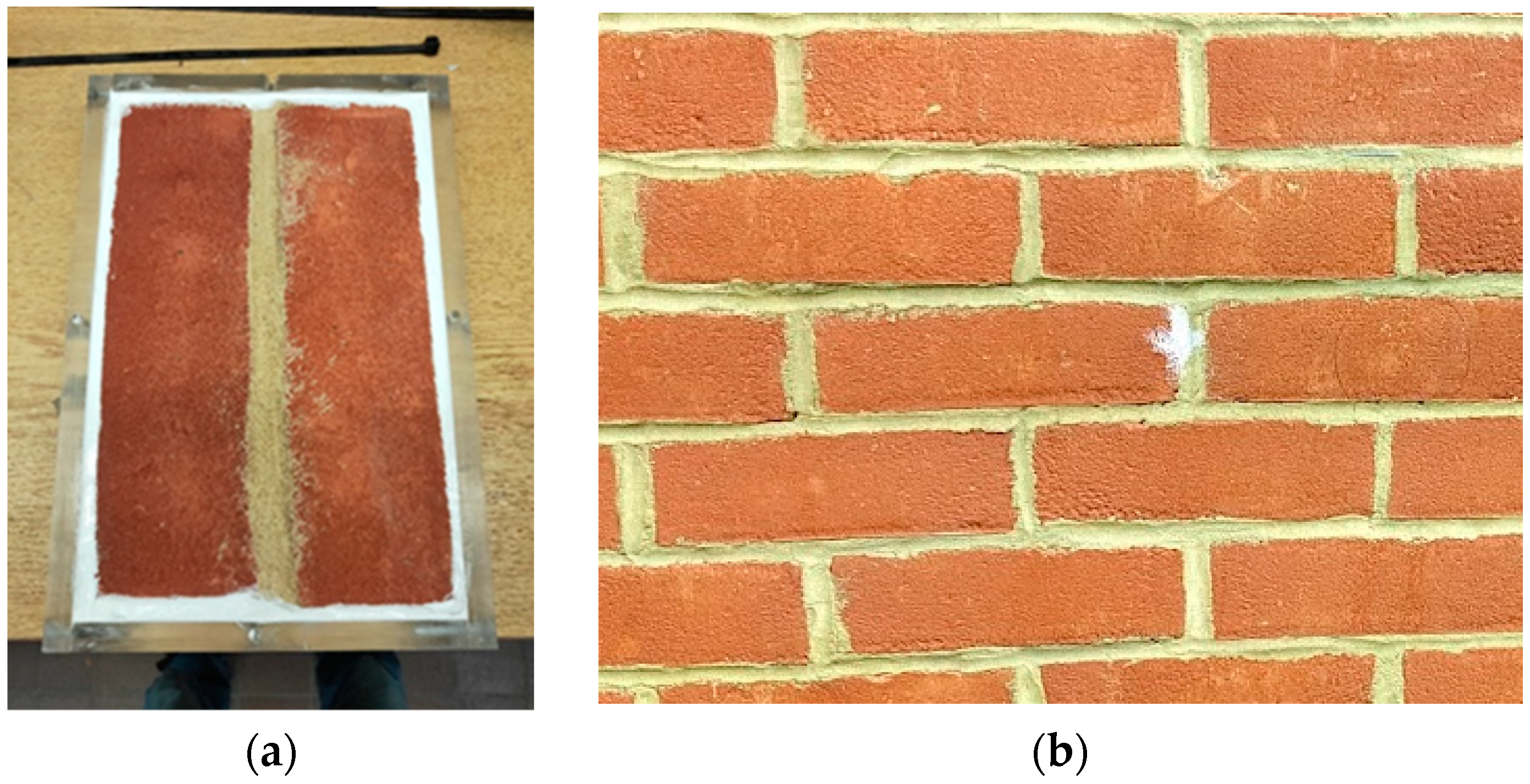
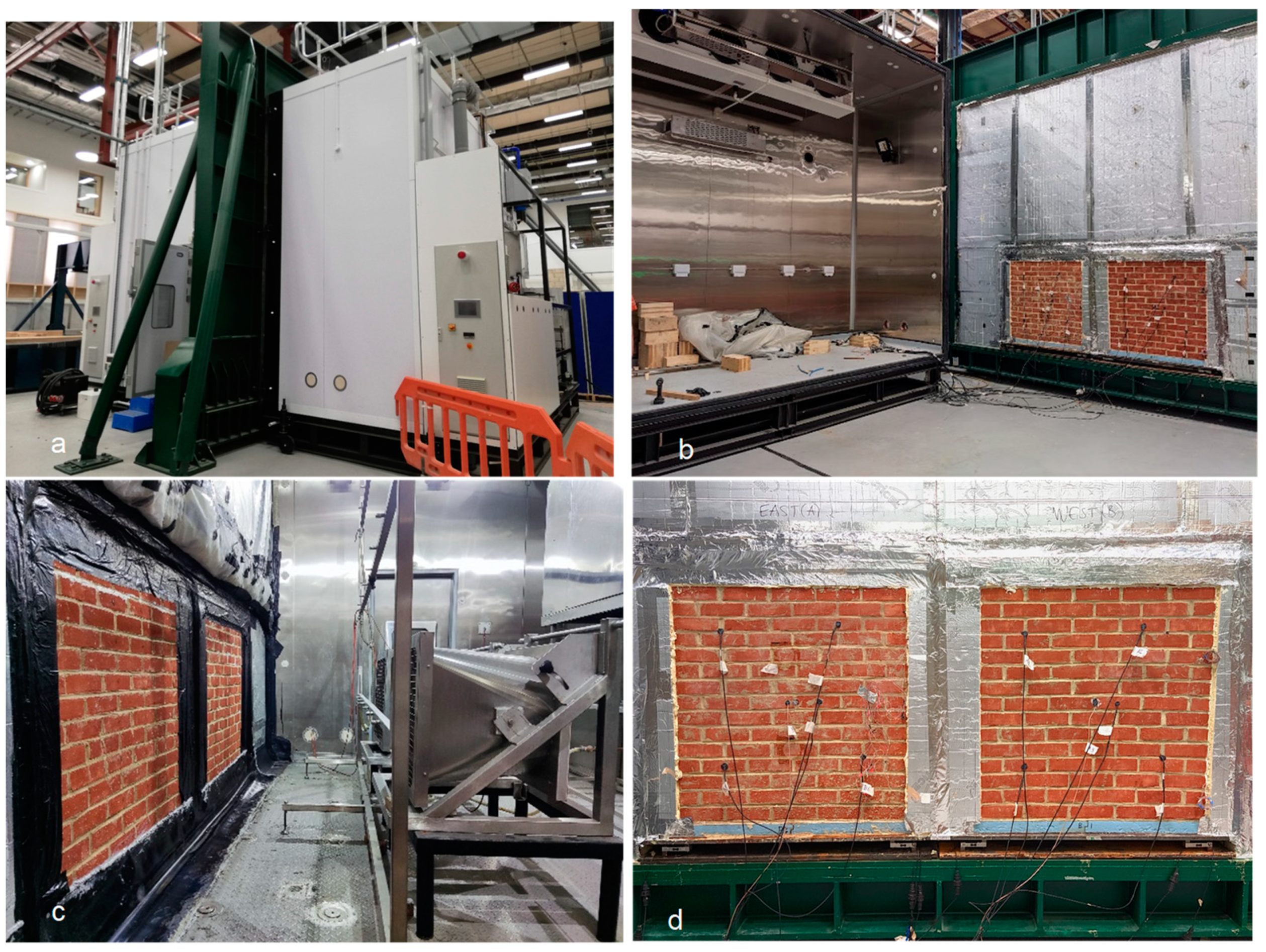
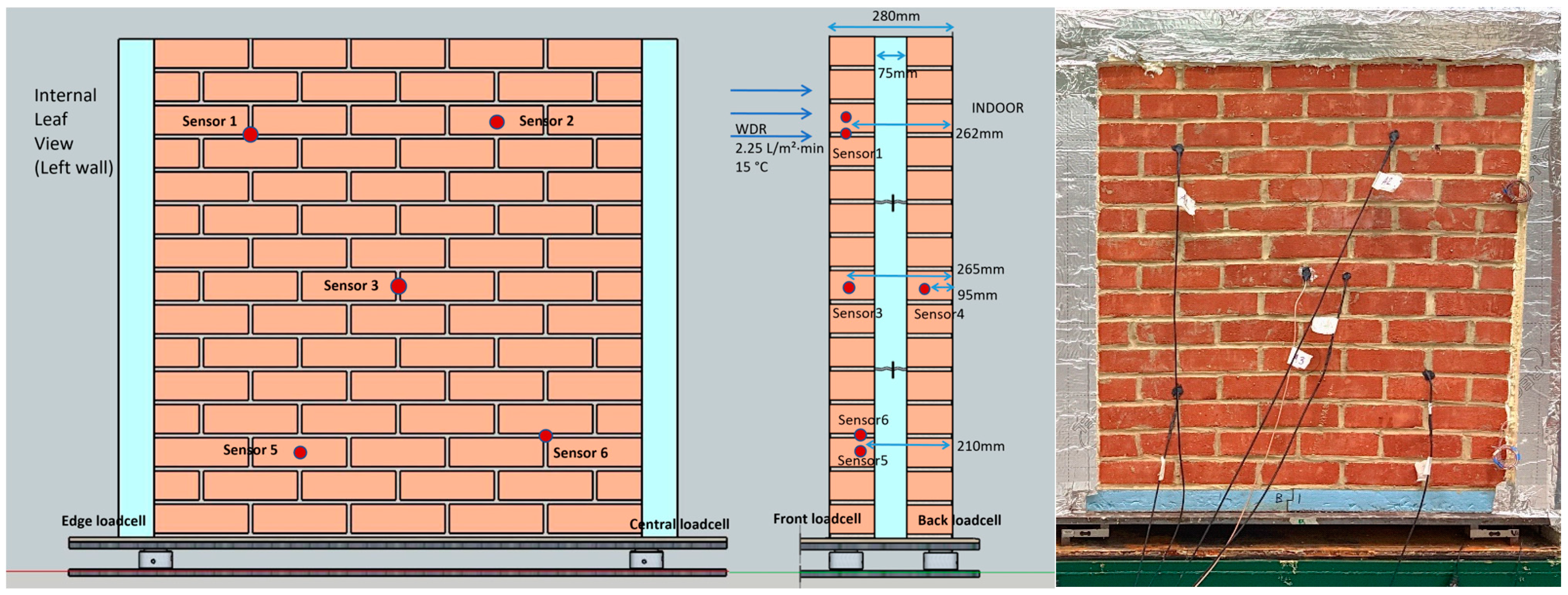

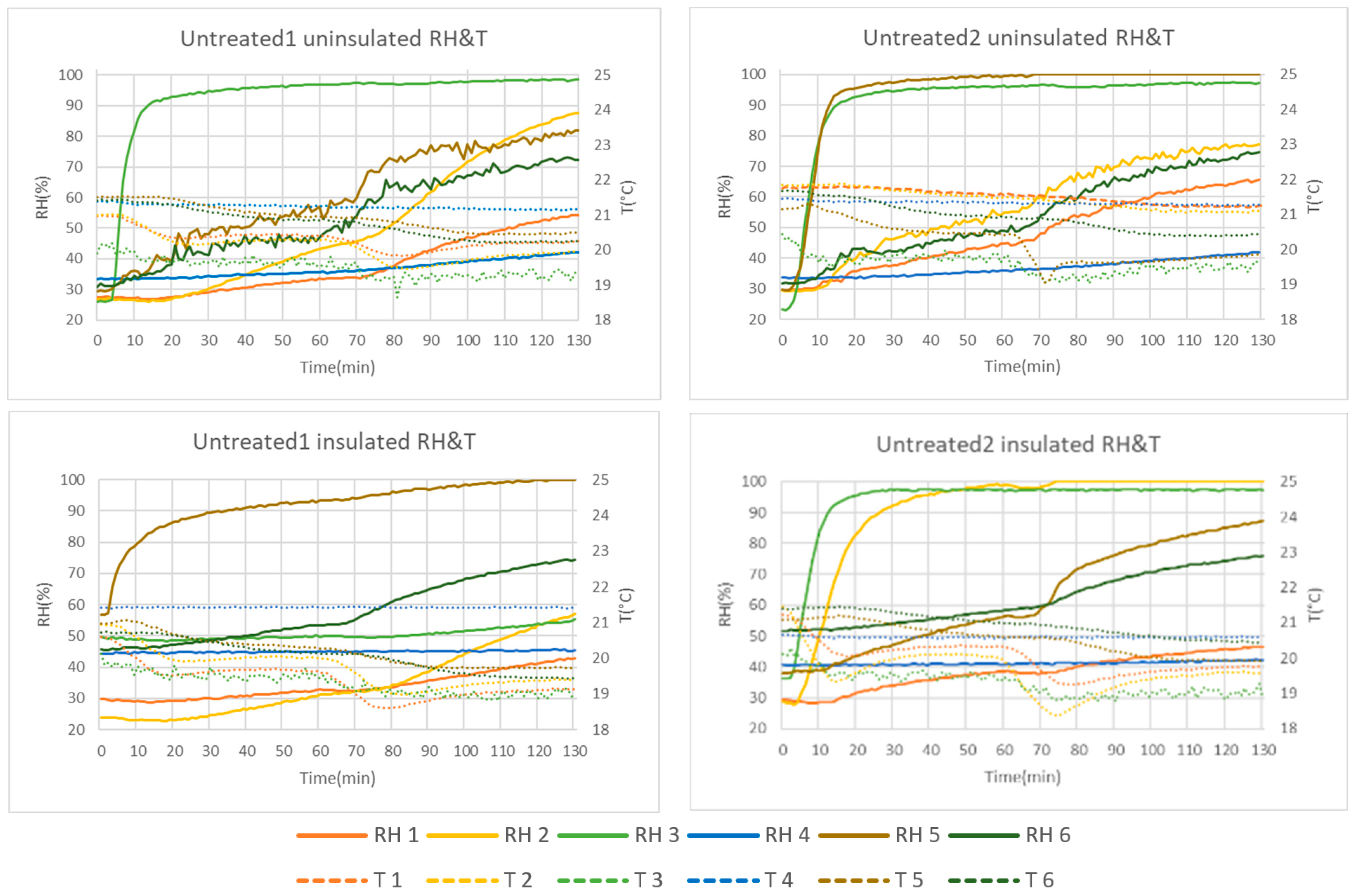

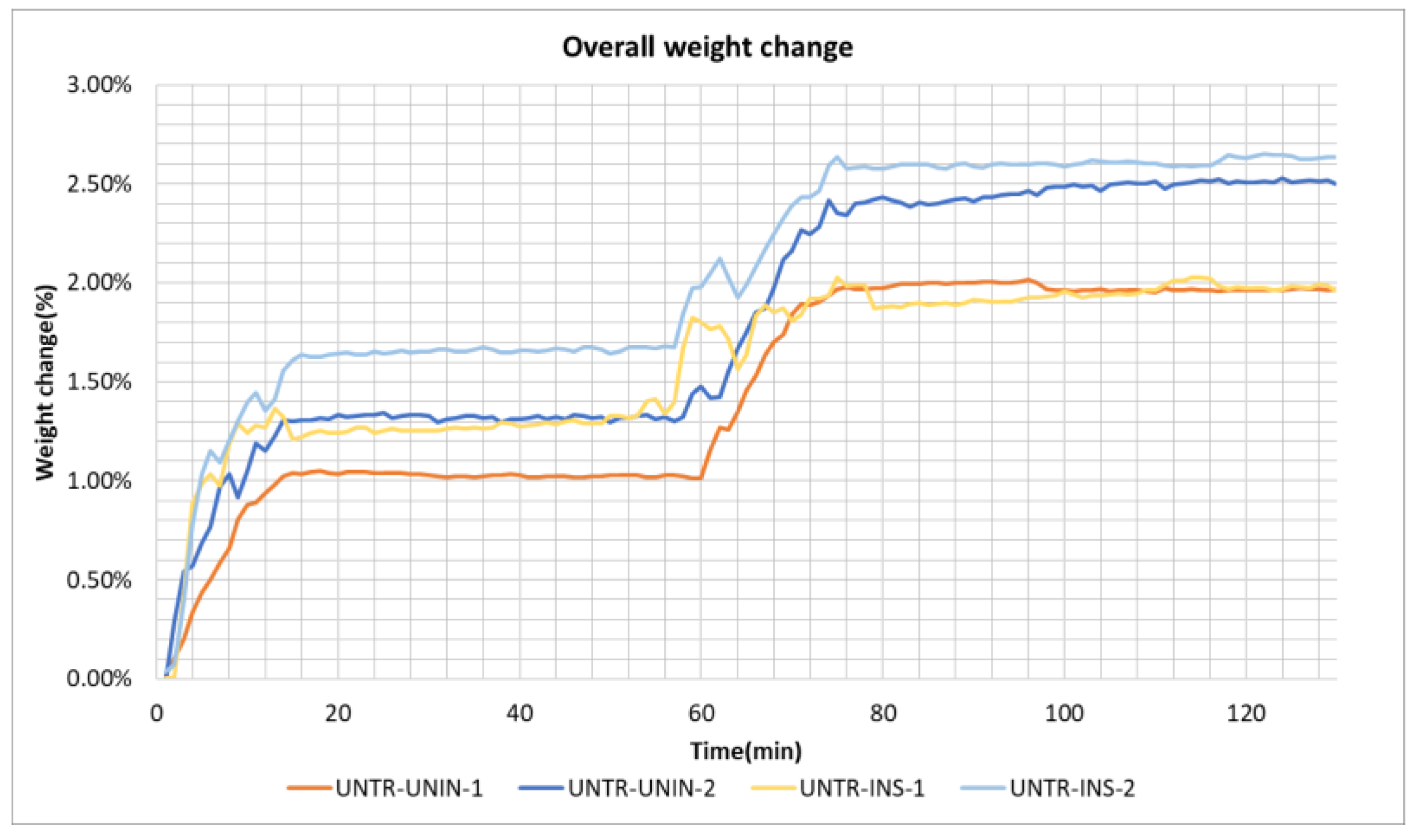

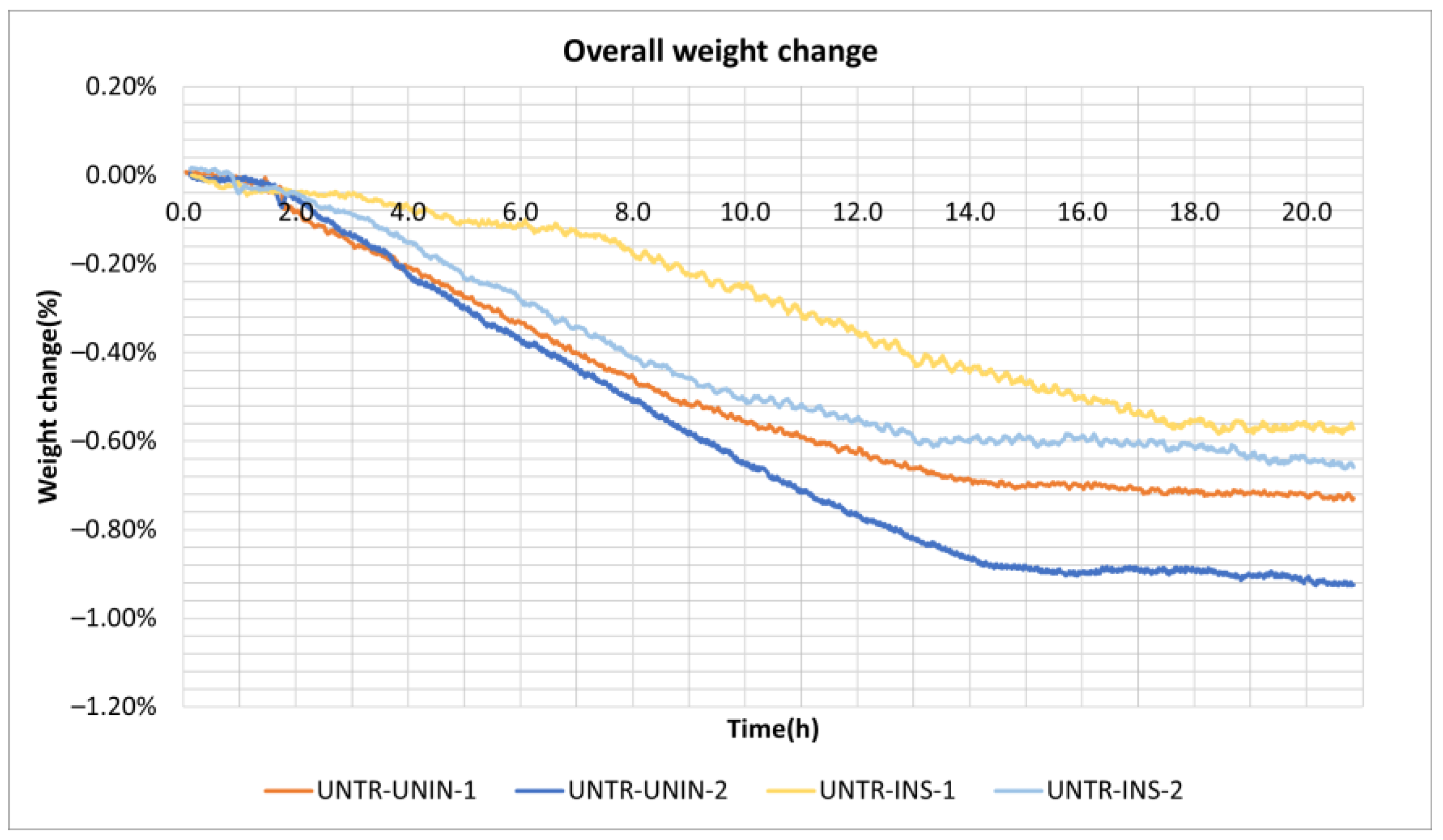
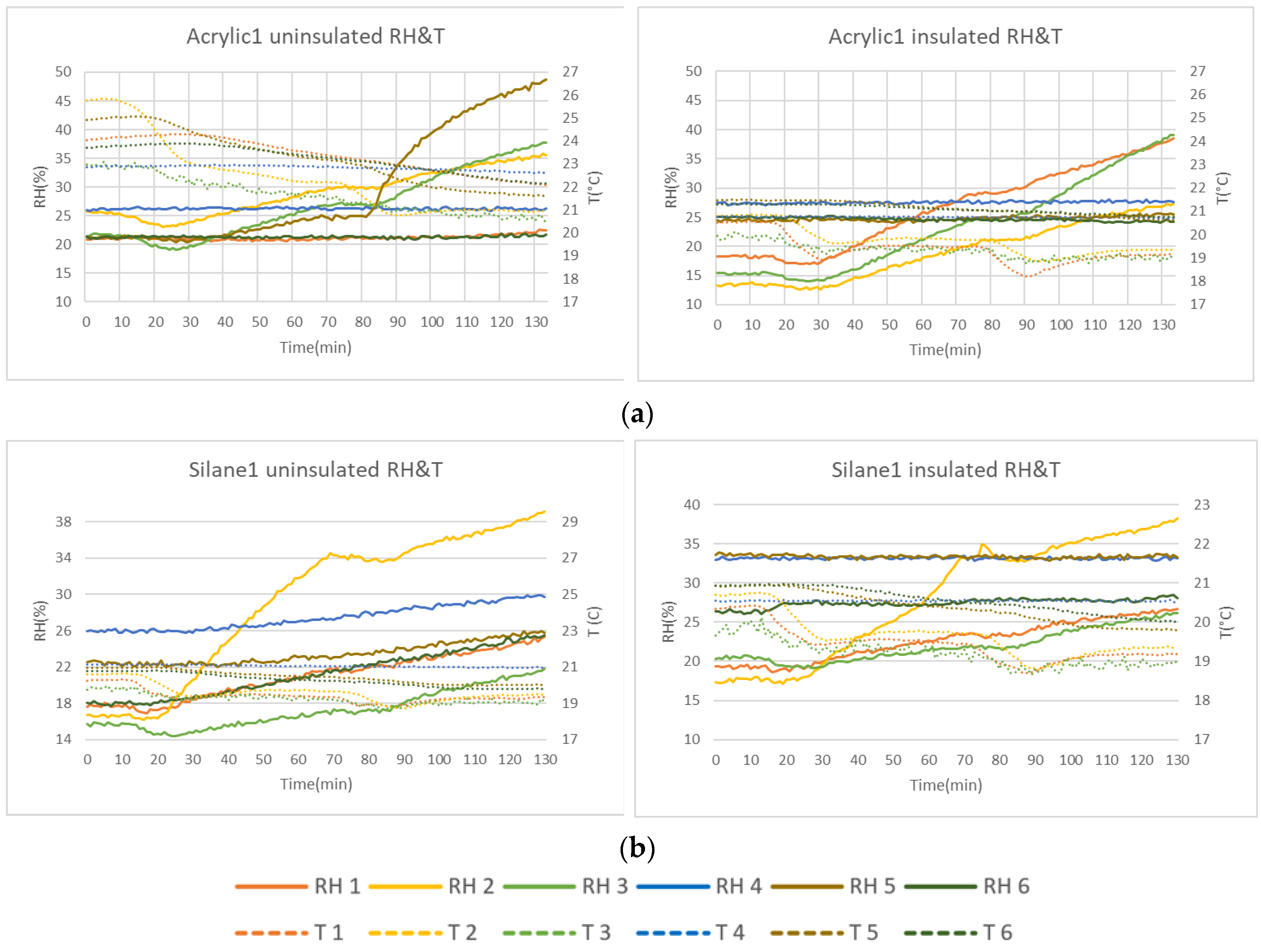

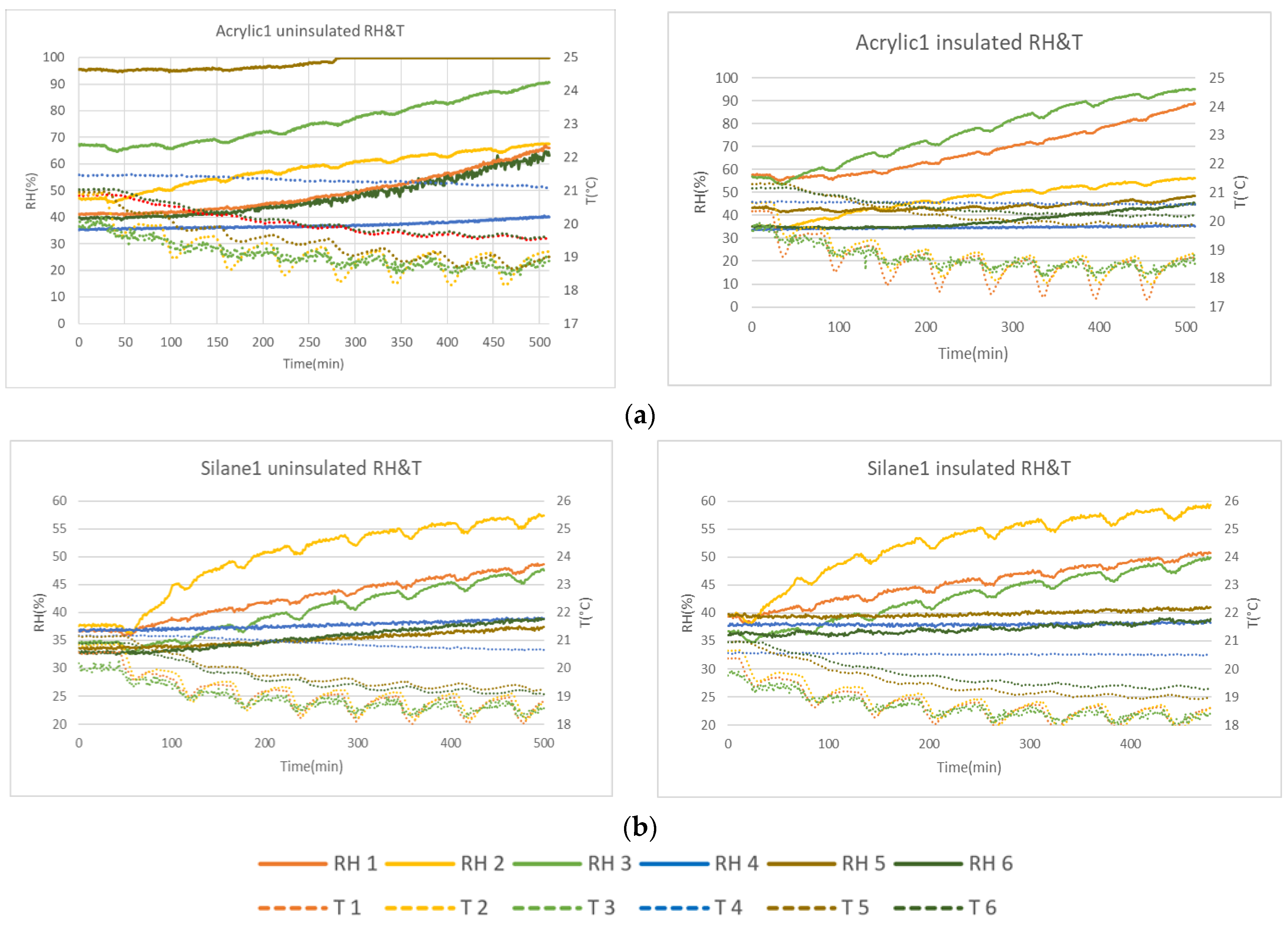


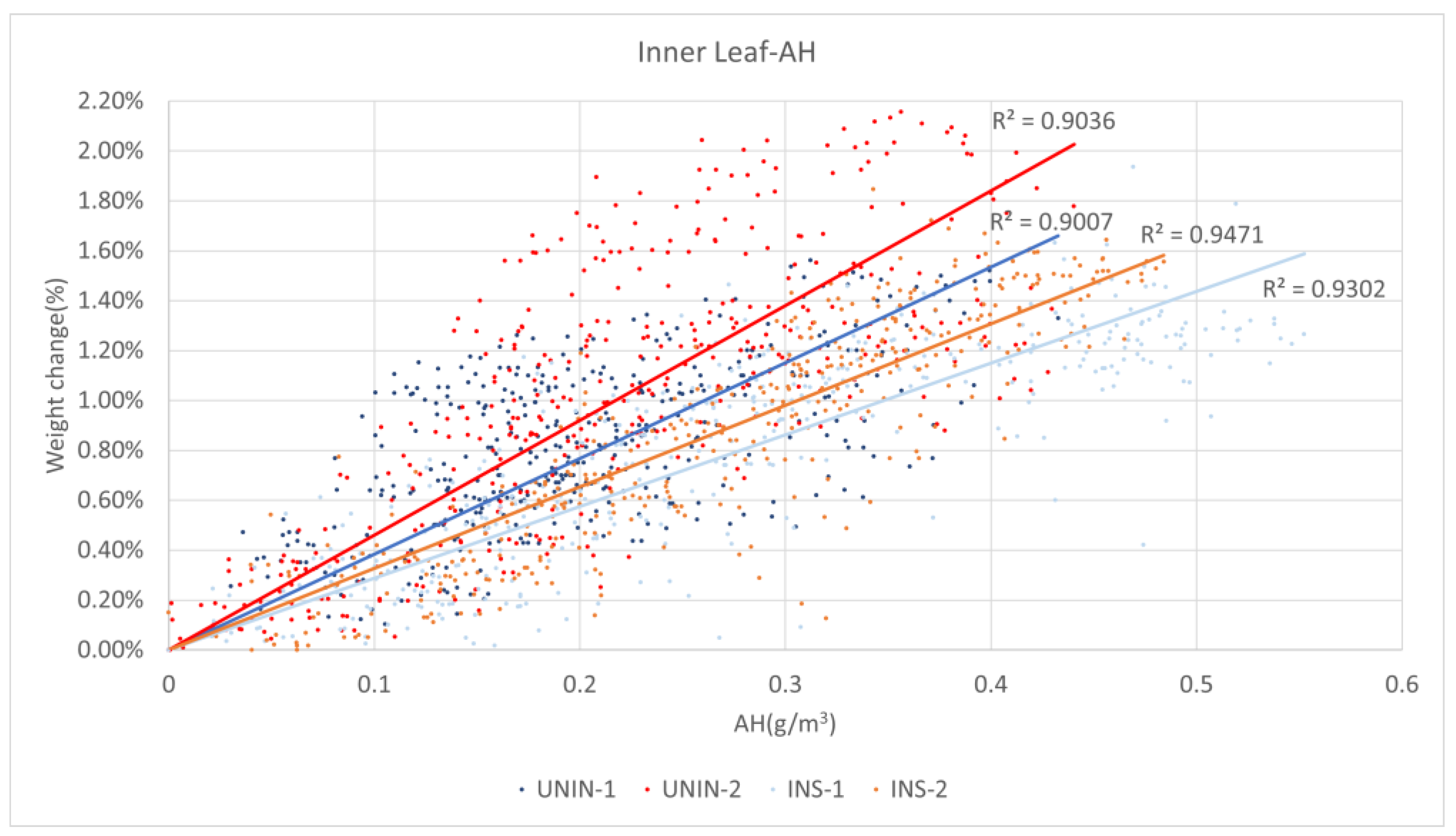
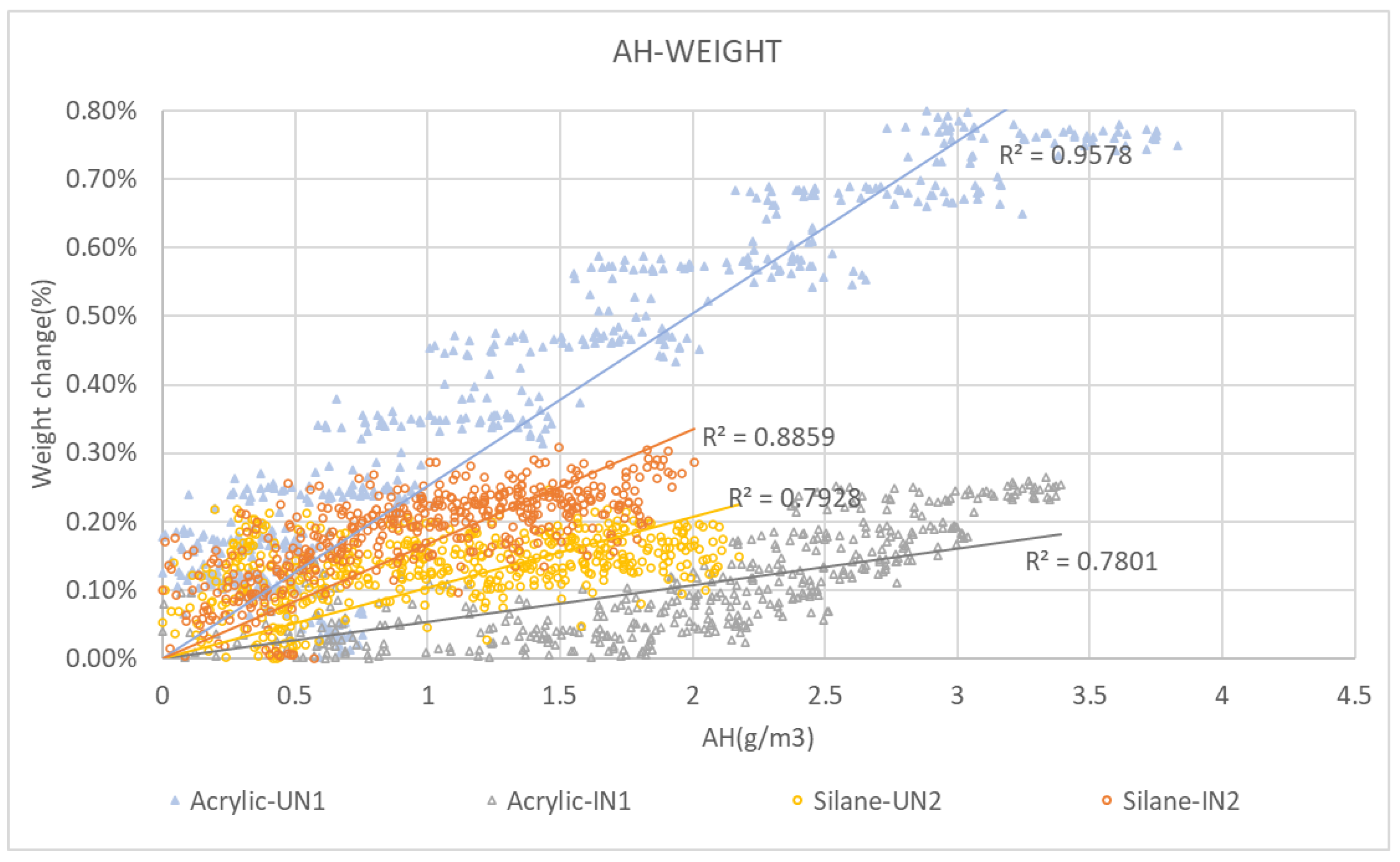
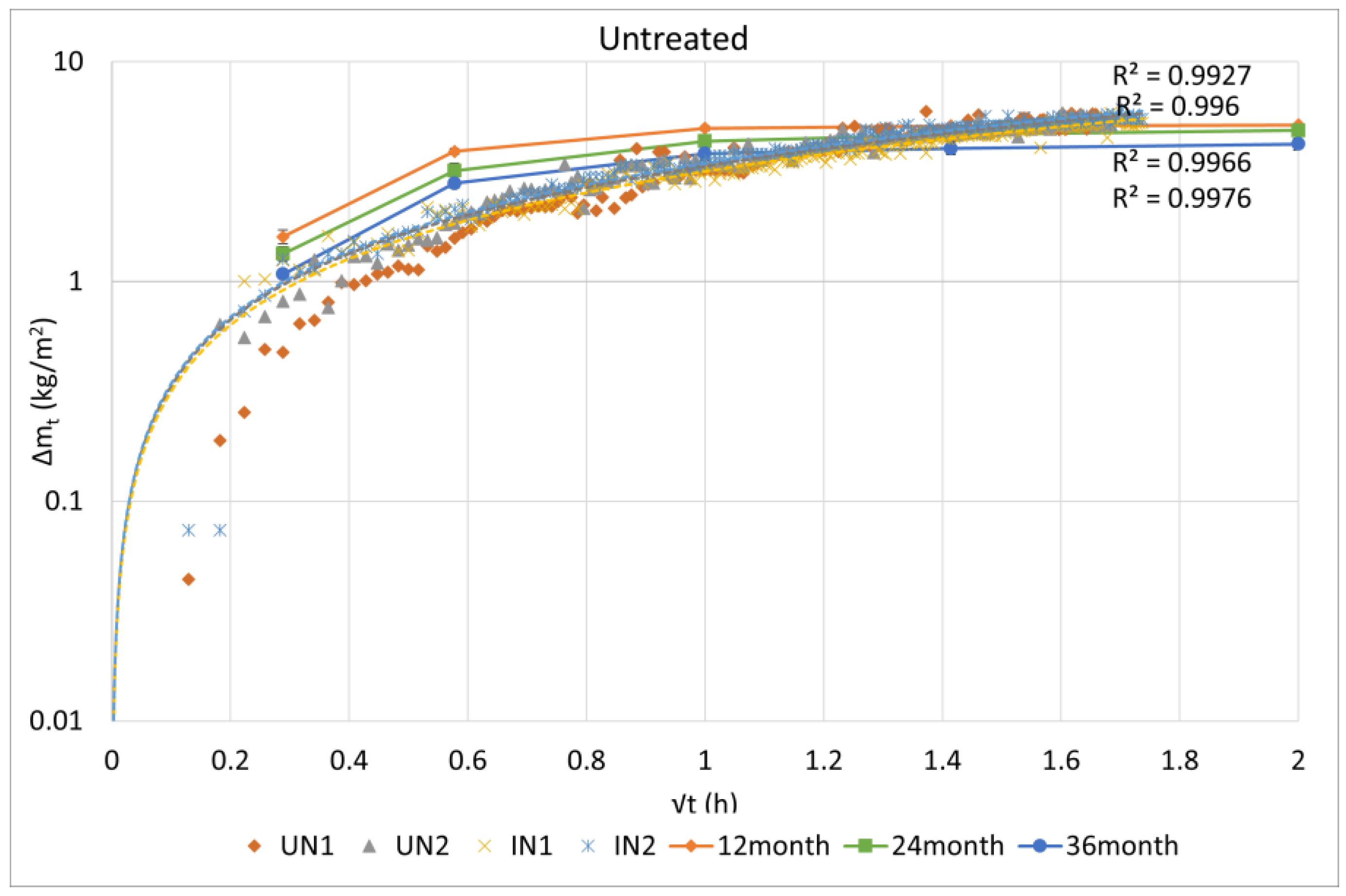
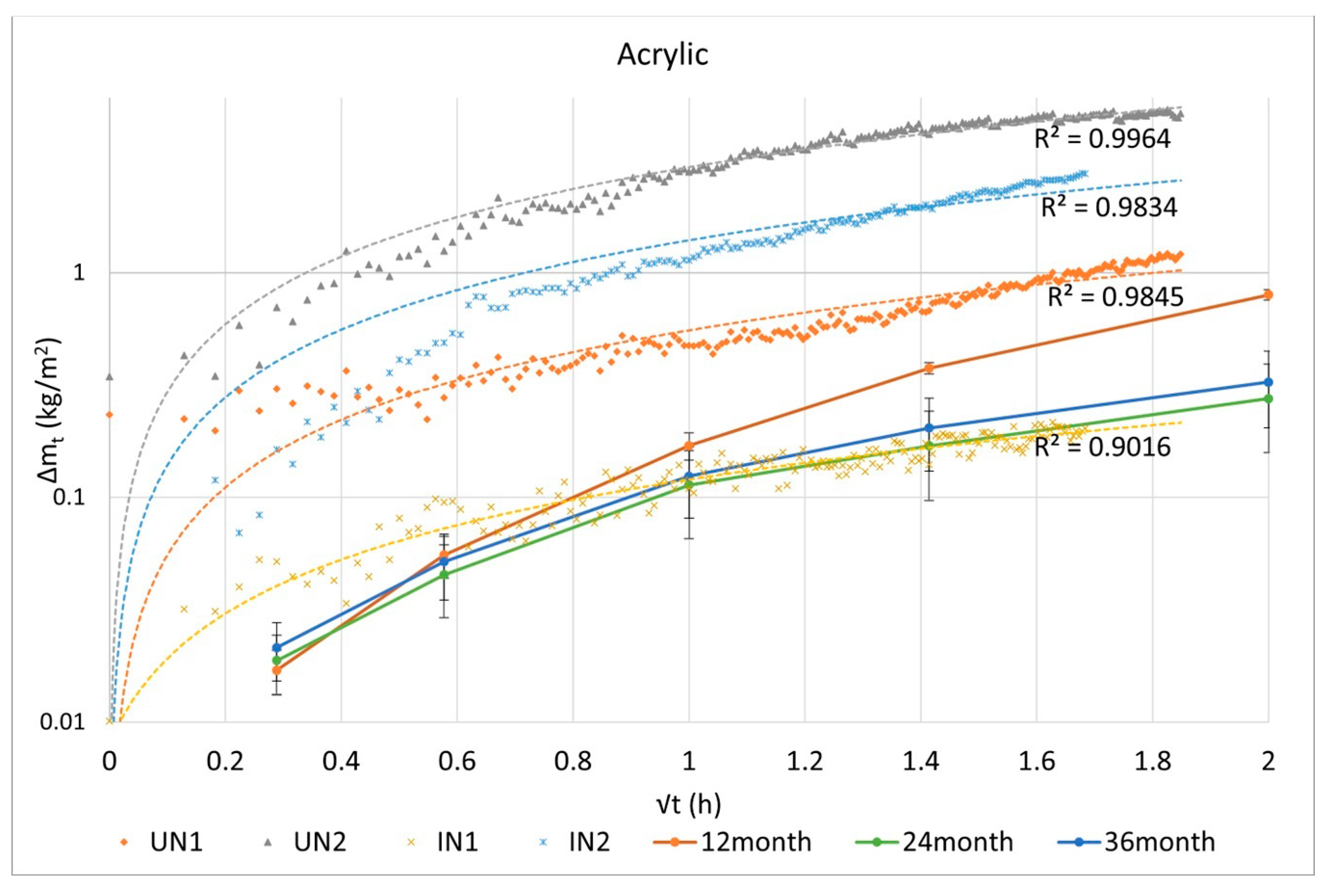
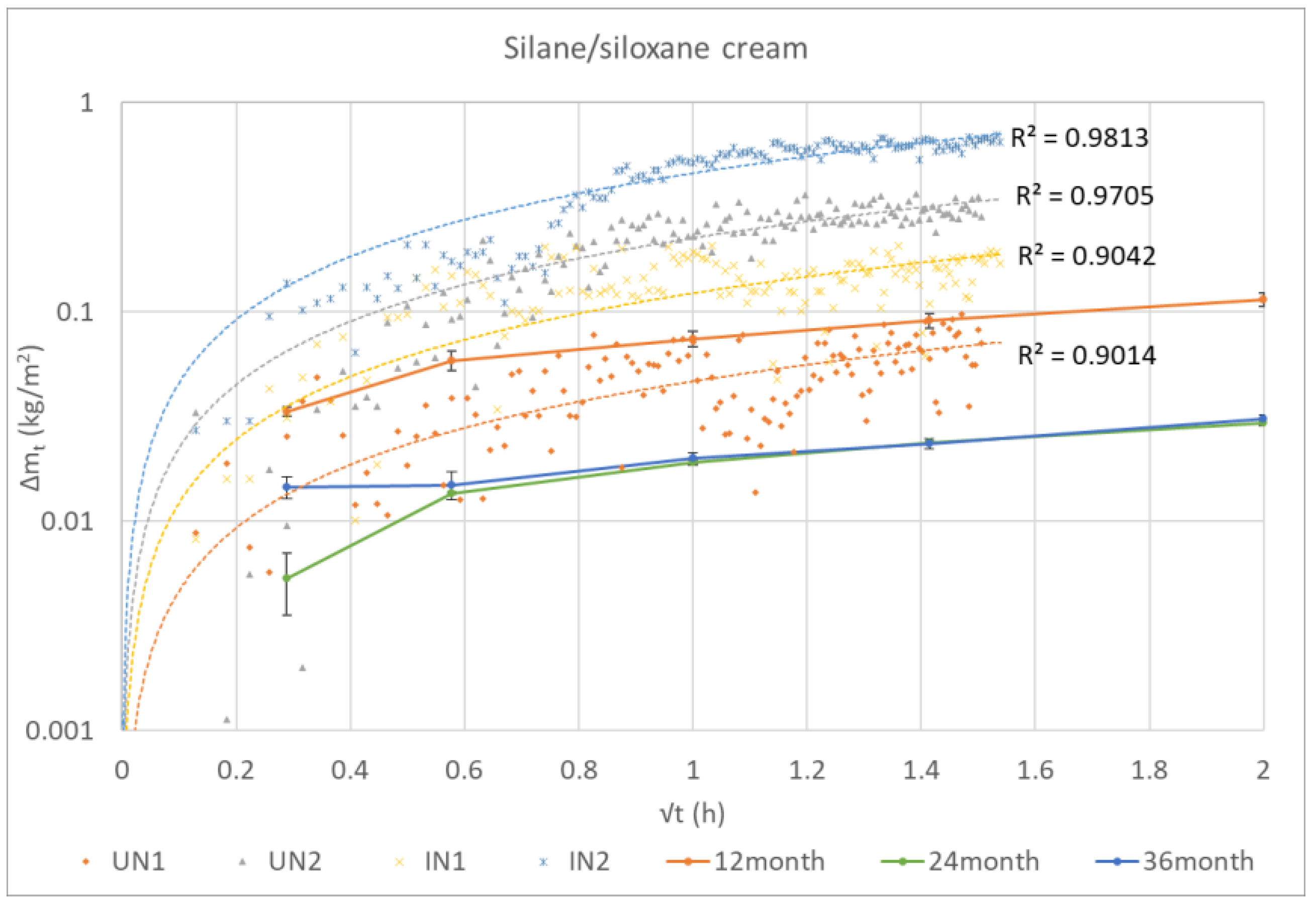
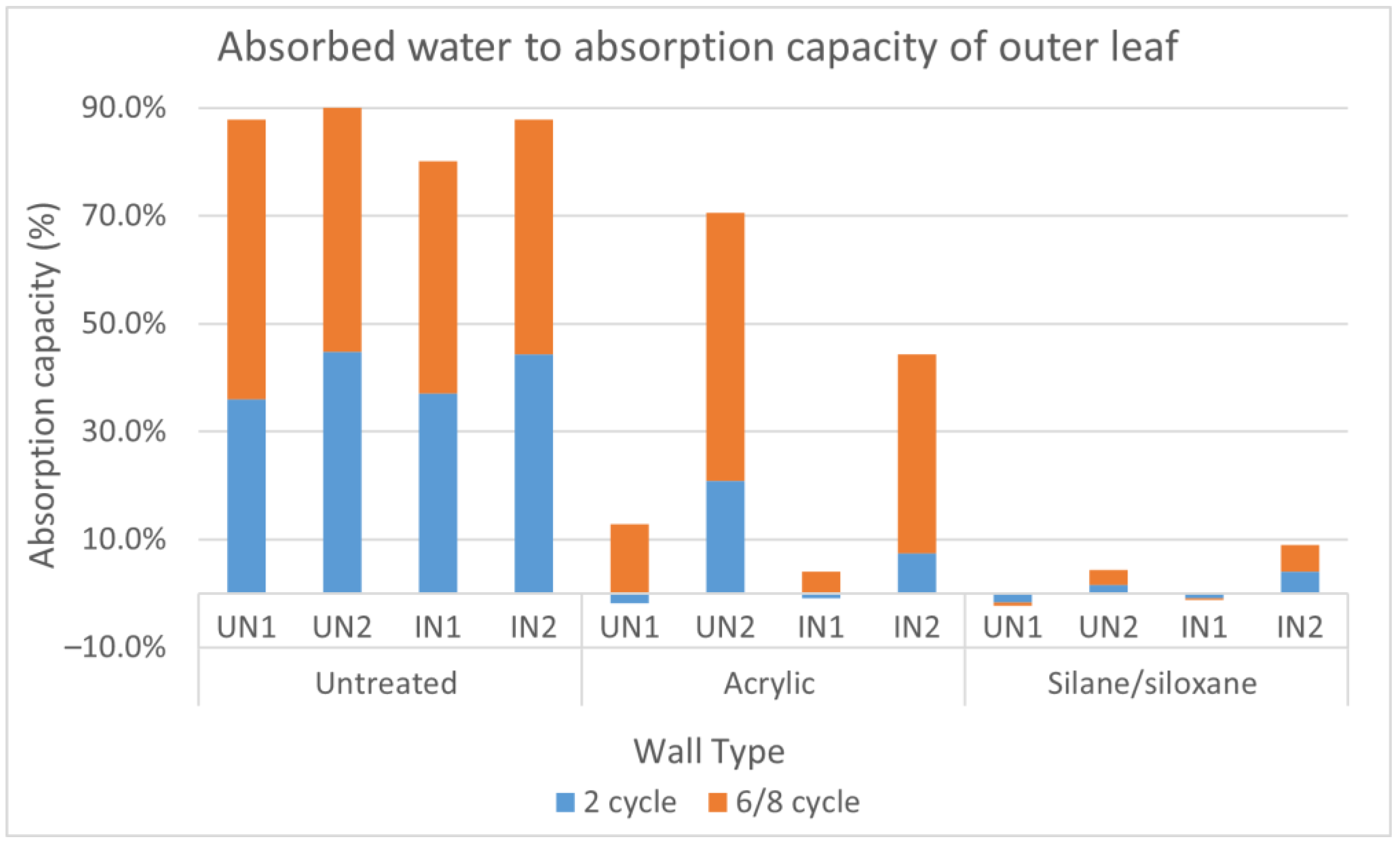
| Product Type | Service Life | Number of Coats | Amount per Application | Hydrophobicity (Average Contact Angle) | Water Absorption (% to Untreated) | Vapour Transmission (% to Untreated) | Bench Test Outcome Summary |
|---|---|---|---|---|---|---|---|
| Acrylic-based liquid | 10 years | 2 on absorbent substrates | 2–6 L/m2 | 113.5° ± 5.07° | −39.1% ± 0.94% | +3.6% ± 4.39% | Good hydrophobicity, low water resistance, good vapour transmission. |
| Silane/siloxane blend cream | 25 years | 1 | 5 L/m2 | 102.8° ± 10.33° | −96.3% ± 0.19% | +17.9% ± 7.24% | Inconsistent hydrophobicity, effective water resistance, low vapour transmission. |
| Instrument Type | Manufacturer | Model | Number per Wall | Measuring Range | Accuracy |
|---|---|---|---|---|---|
| T and RH sensor | Measurement Specialties Hampton, VA, USA | HTM2500LF | 5 | 1–99% RH, −40–85 °C | ±3% RH |
| High resolution T and RH sensor (RHT 3) | Omni Instruments, Dundee, UK | SC05 | 1 | 0–100% RH, −40–100 °C | at 23 °C and 10, 35, 80% RH ± 0.8% RH/±0.1 K |
| Single-Point Load Cell | PCM, Kenilworth, UK | SP-1022 | 4 | 0–200 kg | Linearity ± 0.04 kg |
| Test Method | Test Purpose | Test Type | Water Application Rate | Wind Speed | Duration | Nature of Result |
|---|---|---|---|---|---|---|
| BS EN 12155:2000 [45] | Curtain walling lab test at static pressure | Static pressure sequence | 2 L/m2·min | 150–600+ Pa, 15.6–31.3+ m/s | Up to 50 min | Pressure limit to failure |
| BS EN 13050:2011 [46] | Curtain walling dynamic lab test (pulses @ 5 s in vertical passes across wall) | Dynamic pressure pulses | 2 L/m2·min or higher | Design pressure | Time required for vertical passes | Pressure limit to failure |
| BS EN 13051:2001 [47] | Curtain walling site test | Static spray rate | 5 L/min per metre length of spray bar | - | 30 min | ‘Pass’ after 30 min |
| BS EN 12865:2001 [38] | External wall tested under pulsing air pressure (every 15 s) | Static by steps | 1.5 L/m2·min surface and 1.2 L/m min at top | 150–600+ Pa, 15.6–31.3+ m/s | 1 h (a) | Pressure limit to failure (a) Absorbed kg/m2 (b) |
| 5 h (b) | ||||||
| BS EN 1027:2016 [48] | Water tightness of windows and doors | Static by steps | 2 L/m2·min | 150–600+ Pa, 15.6–31.3+ m/s | Time required for water penetration | Pressure limit to failure |
| ASTM C1601-22a, E514 [49,50] | Masonry lab/site test | Static spray rate and pressure | 2.3 L/m2·min | 500 Pa, 28.6 m/s | Steady penetration or 4 h | Absorbed litres/hour |
| BS 4315-2:1970 [51] | Permeable wall water penetration test (1 min every 30 min (a), 6 h in 24 h (b)) | Cyclic water application | 0.5 L/m2·min | 250 Pa, 20.1 m/s | 48 h (a) | % absorption |
| Any number of days (b) | ||||||
| Weather data | Swansea 2012–2017 (WDR index = 116 L/m2 spell) | - | 0.13 L/m2·min | 185 Pa, 17.4 m/s | 13 h (To 100 L) | - |
| Phase | Test | Duration | Condition |
|---|---|---|---|
| 1 | 2 wetting cycles | 2 h | 10 min wetting at 2.25 L/m2·min, 15 °C and 50 min conditioning at 20 °C. |
| 2 | Overnight drying | 20 h | 20 °C, 50% RH |
| 3 | Untreated/treated: 6/8 wetting cycles | 6 h/8 h | 10 min wetting at 2.25 L/m2·min, 15 °C and 50 min conditioning at 20 °C. |
| 4 | Post-test conditioning | 22 h | 20 °C, 50% RH |
| Test Event | Quantity | Unit |
|---|---|---|
| Average flow rate | 2.25 | L/m2·min |
| Wetting time per cycle | 10 | min/cycle |
| Wall surface area | 1.21 | m2 |
| Amount of water dispersed to specimen per cycle | 27.22 | L |
| Phases 1–2 cycles | 45 | L/m2 |
| Phases 3–6 cycles (untreated) | 135 | L/m2 |
| Phases 3–8 cycles (treated) | 180 | L/m2 |
| Total (untreated) | 180 | L/m2 |
| Total (treated) | 225 | L/m2 |
| Waterproofing and Insulation Conditions | ||||||||||||
|---|---|---|---|---|---|---|---|---|---|---|---|---|
| Untreated | Acrylic | Silane/Siloxane | ||||||||||
| Phase | UN1 | UN2 | IN1 | IN2 | UN1 | UN2 | IN1 | IN2 | UN1 | UN2 | IN1 | IN2 |
| 2 cycles | 1.97% | 2.50% | 1.96% | 2.62% | 0.18% | 1.69% | −0.03% | 0.61% | −0.07% | 0.17% | 0.02% | 0.29% |
| Day 1 drying | −0.53% | −0.52% | 0.39% | 0.18% | −0.16% | −0.60% | 0.08% | 0.03% | 0.11% | −0.06% | 0.17% | 0.05% |
| 6/8 cycles | 3.41% | 3.02% | 2.28% | 2.56% | 0.76% | 2.83% | 0.24% | 1.93% | −0.03% | 0.15% | −0.01% | 0.25% |
| Day 2 drying | −0.65% | −0.82% | −0.07% | −0.68% | −0.15% | −0.38% | 0.05% | −0.04% | 0.08% | 0.04% | 0.18% | −0.02% |
| Final | 4.18% | 4.18% | 4.56% | 4.68% | 0.63% | 3.55% | 0.35% | 2.53% | 0.10% | 0.31% | 0.36% | 0.57% |
| Untreated | Acrylic | Silane/Siloxane | ||||||||||
|---|---|---|---|---|---|---|---|---|---|---|---|---|
| Phase | UN1 | UN2 | IN1 | IN2 | UN1 | UN2 | IN1 | IN2 | UN1 | UN2 | IN1 | IN2 |
| 2 Cycles | 17.9% | 22.3% | 18.5% | 22.0% | −0.9% | 10.4% | −0.5% | 3.7% | −0.8% | 0.8% | −0.4% | 2.0% |
| 6/8 Cycles | 8.6% | 7.8% | 7.1% | 7.2% | 1.6% | 6.2% | 0.5% | 4.6% | −0.1% | 0.3% | 0.0% | 0.6% |
| Total | 10.9% | 11.4% | 10.0% | 10.9% | 1.1% | 7.0% | 0.3% | 4.4% | −0.2% | 0.4% | −0.1% | 0.9% |
Disclaimer/Publisher’s Note: The statements, opinions and data contained in all publications are solely those of the individual author(s) and contributor(s) and not of MDPI and/or the editor(s). MDPI and/or the editor(s) disclaim responsibility for any injury to people or property resulting from any ideas, methods, instructions or products referred to in the content. |
© 2024 by the authors. Licensee MDPI, Basel, Switzerland. This article is an open access article distributed under the terms and conditions of the Creative Commons Attribution (CC BY) license (https://creativecommons.org/licenses/by/4.0/).
Share and Cite
D’Ayala, D.; Zhu, H.; Aktas, Y. The Impact of Wind-Driven Rain on Surface Waterproofed Brick Cavity Walls. Buildings 2024, 14, 447. https://doi.org/10.3390/buildings14020447
D’Ayala D, Zhu H, Aktas Y. The Impact of Wind-Driven Rain on Surface Waterproofed Brick Cavity Walls. Buildings. 2024; 14(2):447. https://doi.org/10.3390/buildings14020447
Chicago/Turabian StyleD’Ayala, Dina, Hengrui Zhu, and Yasemin Aktas. 2024. "The Impact of Wind-Driven Rain on Surface Waterproofed Brick Cavity Walls" Buildings 14, no. 2: 447. https://doi.org/10.3390/buildings14020447
APA StyleD’Ayala, D., Zhu, H., & Aktas, Y. (2024). The Impact of Wind-Driven Rain on Surface Waterproofed Brick Cavity Walls. Buildings, 14(2), 447. https://doi.org/10.3390/buildings14020447








